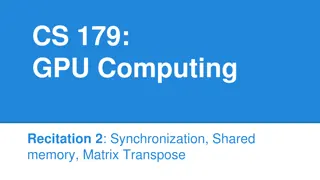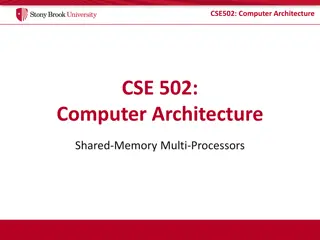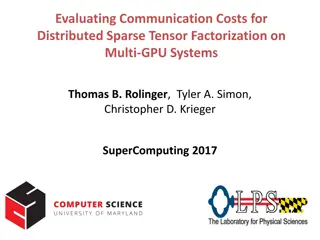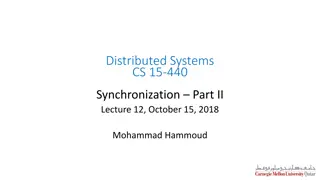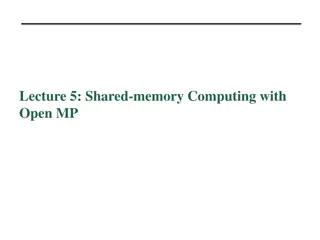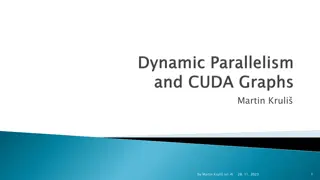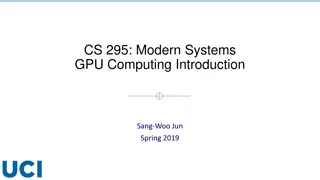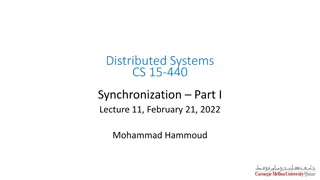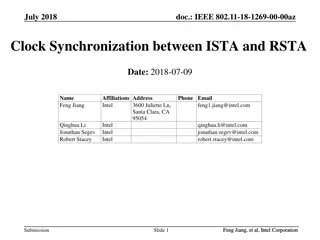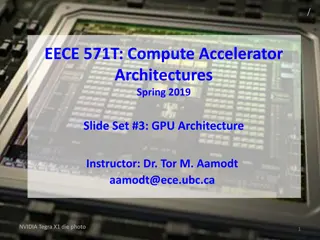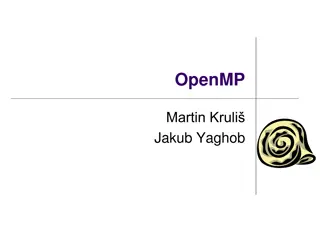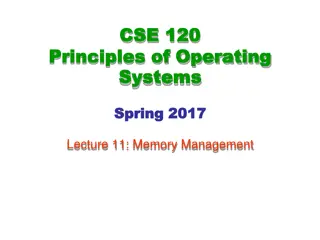Synchronization and Shared Memory in GPU Computing
Synchronization and shared memory play vital roles in optimizing parallelism in GPU computing. __syncthreads() enables thread synchronization within blocks, while atomic instructions ensure serialized access to shared resources. Examples like Parallel BFS and summing numbers highlight the need for synchronization. Following a smart budget advice and utilizing warp shuffles can enhance performance in GPU programming.
Download Presentation

Please find below an Image/Link to download the presentation.
The content on the website is provided AS IS for your information and personal use only. It may not be sold, licensed, or shared on other websites without obtaining consent from the author. Download presentation by click this link. If you encounter any issues during the download, it is possible that the publisher has removed the file from their server.
E N D
Presentation Transcript
CS 179: GPU Computing Recitation 2: Synchronization, Shared memory, Matrix Transpose
Synchronization Ideal case for parallelism: no resources shared between threads no communication between threads Many algorithms that require just a little bit of resource sharing can still be accelerated by massive parallelism of GPU
Examples needing synchronization (1) Parallel BFS (2) Summing a list of numbers (3) Loading data into a GPU s shared memory
__syncthreads() __syncthreads() synchronizes all threads in a block. Remember that shared memory is per block. Every block that is launched will have to allocate shared memory for its own itself on its resident SM. This __synchthreads() call is very useful for kernels using shared memory.
Atomic instructions: motivation Two threads try to increment variable x=42 concurrently. Final value should be 44. Possible execution order: thread 0 load x (=42) into register r0 thread 1 load x (=42) into register r1 thread 0 increment r0 to 43 thread 1 increment r1 to 43 thread 0 store r0 (=43) into x thread 1 store r1 (=43) into x Actual final value of x: 43 :(
Atomic instructions An atomic instruction executes as a single unit, cannot be interrupted. Serializes access
Atomic instructions on CUDA atomic{Add, Sub, Exch, Min, Max, Inc, Dec, CAS, And, Or, Xor} Syntax: atomicAdd(float *address, float val) Work in both global and shared memory!
(Synchronization) budget advice Do more cheap things and fewer expensive things! Example: computing sum of list of numbers Naive: each thread atomically increments each number to accumulator in global memory
Sum example Smarter solution: each thread computes its own sum in register THIS DOESN T EXIST ANYMORE UPDATE ME use warp shuffle (next slide) to compute sum over warp each warp does a single atomic increment to accumulator in global memory Reduce number of atomic instructions by a factor of 32 (warp size)
Warp-synchronous programming What if I only need to synchronize between all threads in a warp? Warps are already synchronized! Can reduce __syncthreads() calls
Quick Aside: blur_v from Lab 1 Shared memory is great place to put blur_v. 1) blur_v is relatively small and easily fits in shared memory. 2) Every thread reads from blur_v 3) Stride 0 access. No bank conflicts when i > GAUSSIAN_SIZE (majority of threads)
Lab 2 (1) Questions on latency hiding, thread divergence, coalesced memory access, bank conflicts, instruction dependencies (2) What you actually have to do: Need to comment on all non-coalesced memory accesses and bank conflicts in provided kernel code. Lastly, improve the matrix transpose kernel by using cache and memory optimizations.
Matrix Transpose An interesting IO problem, because you have a stride 1 access and a stride n access. Not a trivial access pattern like blur_v from Lab 1. Transpose is just a fancy memcpy, so memcpy provides a great performance target. Note: This example output is for a clean project without the shmem and optimal kernels completed. Your final output should show a decline in kernel time for the different kernels.
Matrix Transpose __global__ void naiveTransposeKernel(const float *input, float *output, int n) { // launched with (64, 16) block size and (n / 64, n / 64) grid size // each block transposes a 64x64 block const int i = threadIdx.x + 64 * blockIdx.x; int j = 4 * threadIdx.y + 64 * blockIdx.y; const int end_j = j + 4; for (; j < end_j; j++) { output[j + n * i] = input[i + n * j]; } }
Shared memory & matrix transpose Idea to avoid non-coalesced accesses: Load from global memory with stride 1 Store into shared memory with stride x __syncthreads() Load from shared memory with stride y Store to global memory with stride 1 Choose values of x and y perform the transpose.
Example of an SMs shared memory cache Let s populate shared memory with random integers. Here s what the first 8 of 32 banks look like: Bank Conflicts
Example of an SMs shared memory cache Bank Conflicts
Example of an SMs shared memory cache Bank Conflicts
Example of an SMs shared memory cache Bank Conflicts
Avoiding bank conflicts You can choose x and y to avoid bank conflicts. Remember that there are 32 banks and the GPU runs threads in batches of 32 (called warps). A stride n access to shared memory avoids bank conflicts iff gcd(n, 32) == 1.
ta_utils.cpp Included in the UNIX version of this set Should minimize lag or infinite waits on GPU function calls. Please leave these functions in the code if you are using Titan/Haru/Maki Namespace TA_Utilities


